Evaluating HSC Quality: Methods and User Involvement Impacts
VerifiedAdded on 2024/05/16
|17
|1116
|396
Presentation
AI Summary
This presentation provides an overview of managing quality in health and social care, focusing on methods for evaluating service quality from both internal and external perspectives. Internal evaluation methods include questionnaires, feedback forms, and structured interviews, while external evaluation relies on inspection agencies like the Care Quality Commission (CQC). The presentation also examines the impacts of involving service users in the evaluation process, highlighting both positive outcomes such as increased trust and improved policy-making, and potential negative aspects like biased feedback and increased costs. It concludes by emphasizing the importance of these evaluation methods in ensuring high-quality care in health and social care settings.

MANAGING
QUALITY IN
HEALTH AND
SOCIAL CARE
QUALITY IN
HEALTH AND
SOCIAL CARE
Paraphrase This Document
Need a fresh take? Get an instant paraphrase of this document with our AI Paraphraser
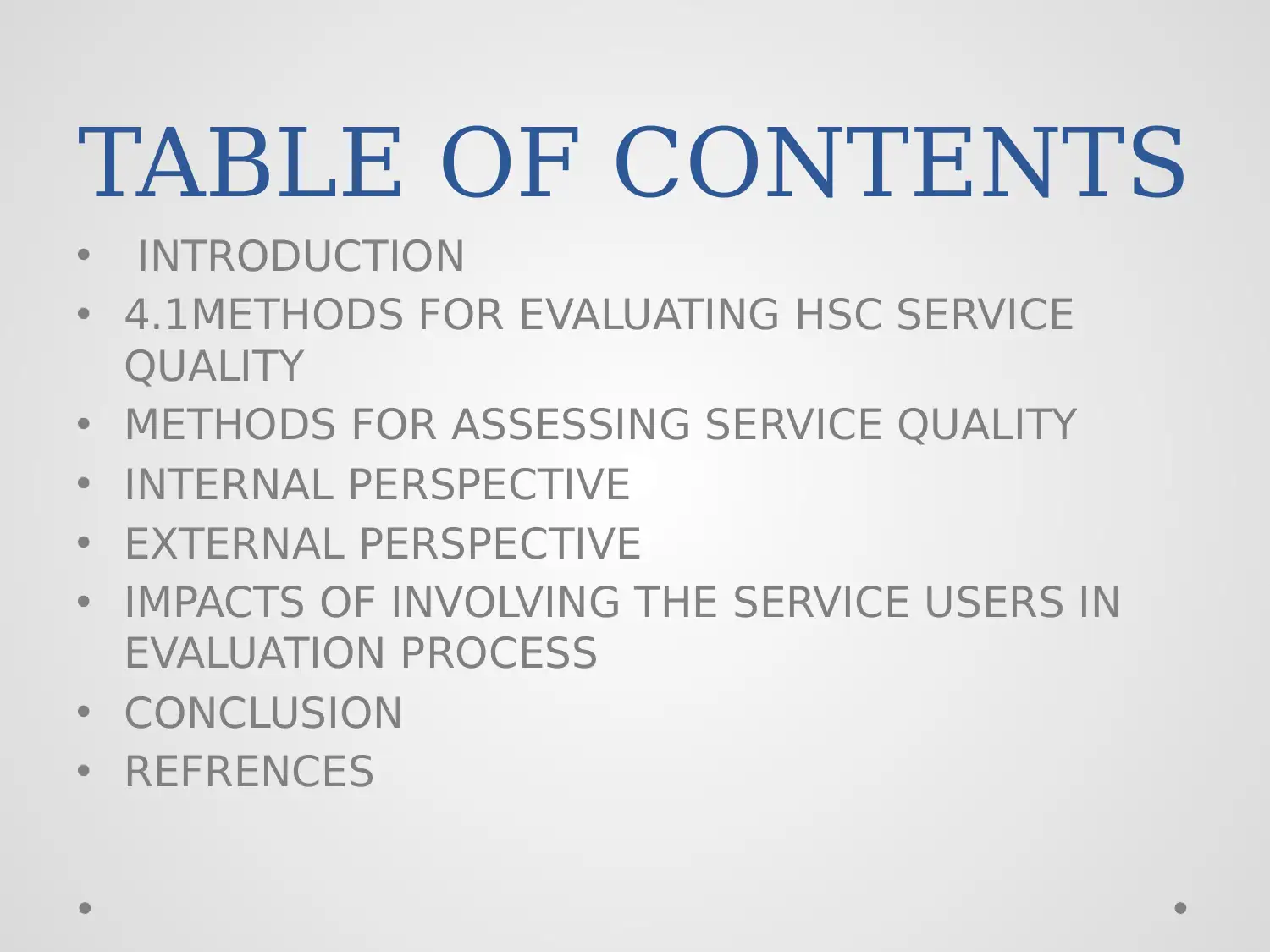
TABLE OF CONTENTS
• INTRODUCTION
• 4.1METHODS FOR EVALUATING HSC SERVICE
QUALITY
• METHODS FOR ASSESSING SERVICE QUALITY
• INTERNAL PERSPECTIVE
• EXTERNAL PERSPECTIVE
• IMPACTS OF INVOLVING THE SERVICE USERS IN
EVALUATION PROCESS
• CONCLUSION
• REFRENCES
• INTRODUCTION
• 4.1METHODS FOR EVALUATING HSC SERVICE
QUALITY
• METHODS FOR ASSESSING SERVICE QUALITY
• INTERNAL PERSPECTIVE
• EXTERNAL PERSPECTIVE
• IMPACTS OF INVOLVING THE SERVICE USERS IN
EVALUATION PROCESS
• CONCLUSION
• REFRENCES
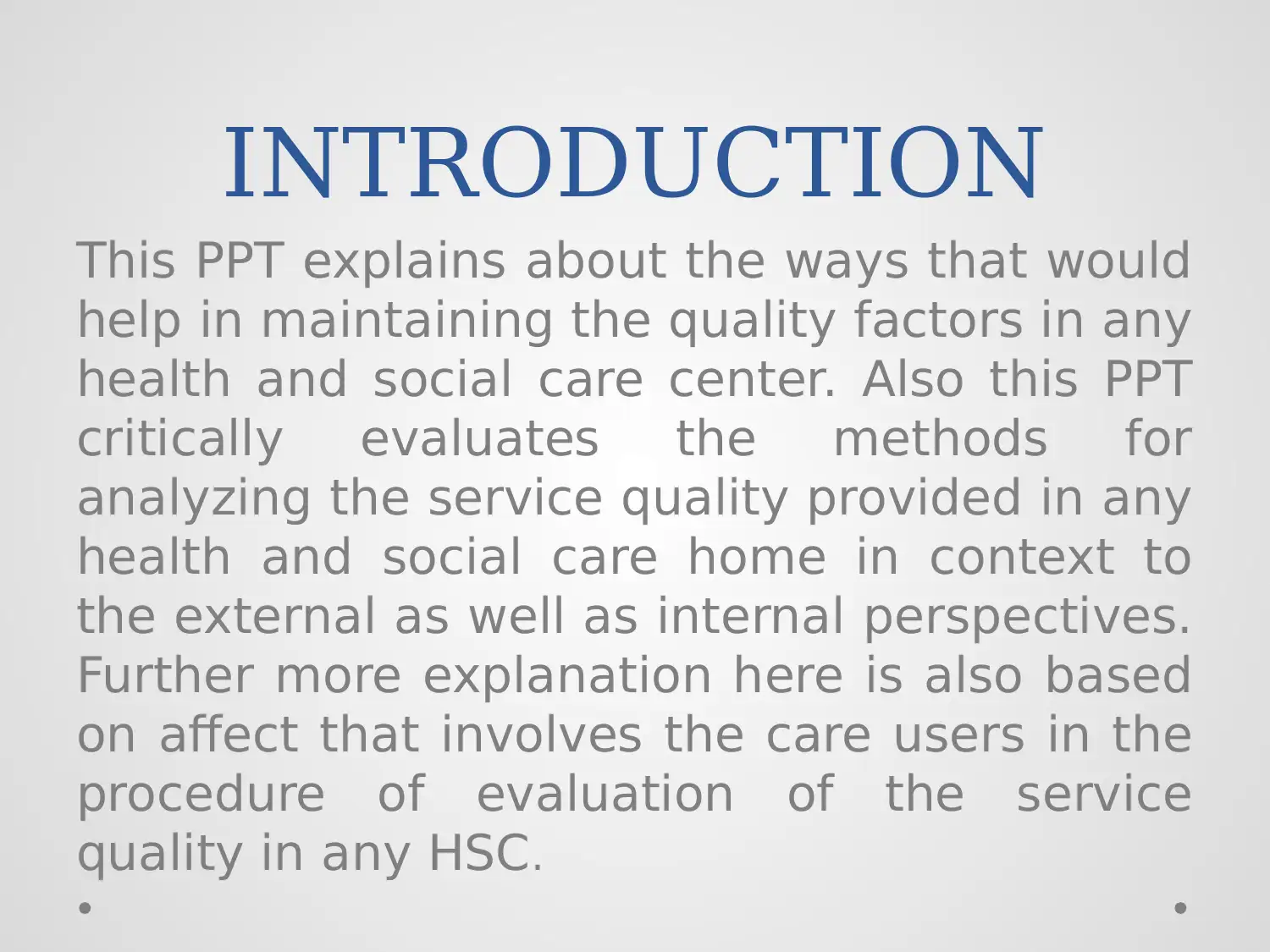
INTRODUCTION
This PPT explains about the ways that would
help in maintaining the quality factors in any
health and social care center. Also this PPT
critically evaluates the methods for
analyzing the service quality provided in any
health and social care home in context to
the external as well as internal perspectives.
Further more explanation here is also based
on affect that involves the care users in the
procedure of evaluation of the service
quality in any HSC.
This PPT explains about the ways that would
help in maintaining the quality factors in any
health and social care center. Also this PPT
critically evaluates the methods for
analyzing the service quality provided in any
health and social care home in context to
the external as well as internal perspectives.
Further more explanation here is also based
on affect that involves the care users in the
procedure of evaluation of the service
quality in any HSC.
⊘ This is a preview!⊘
Do you want full access?
Subscribe today to unlock all pages.

Trusted by 1+ million students worldwide
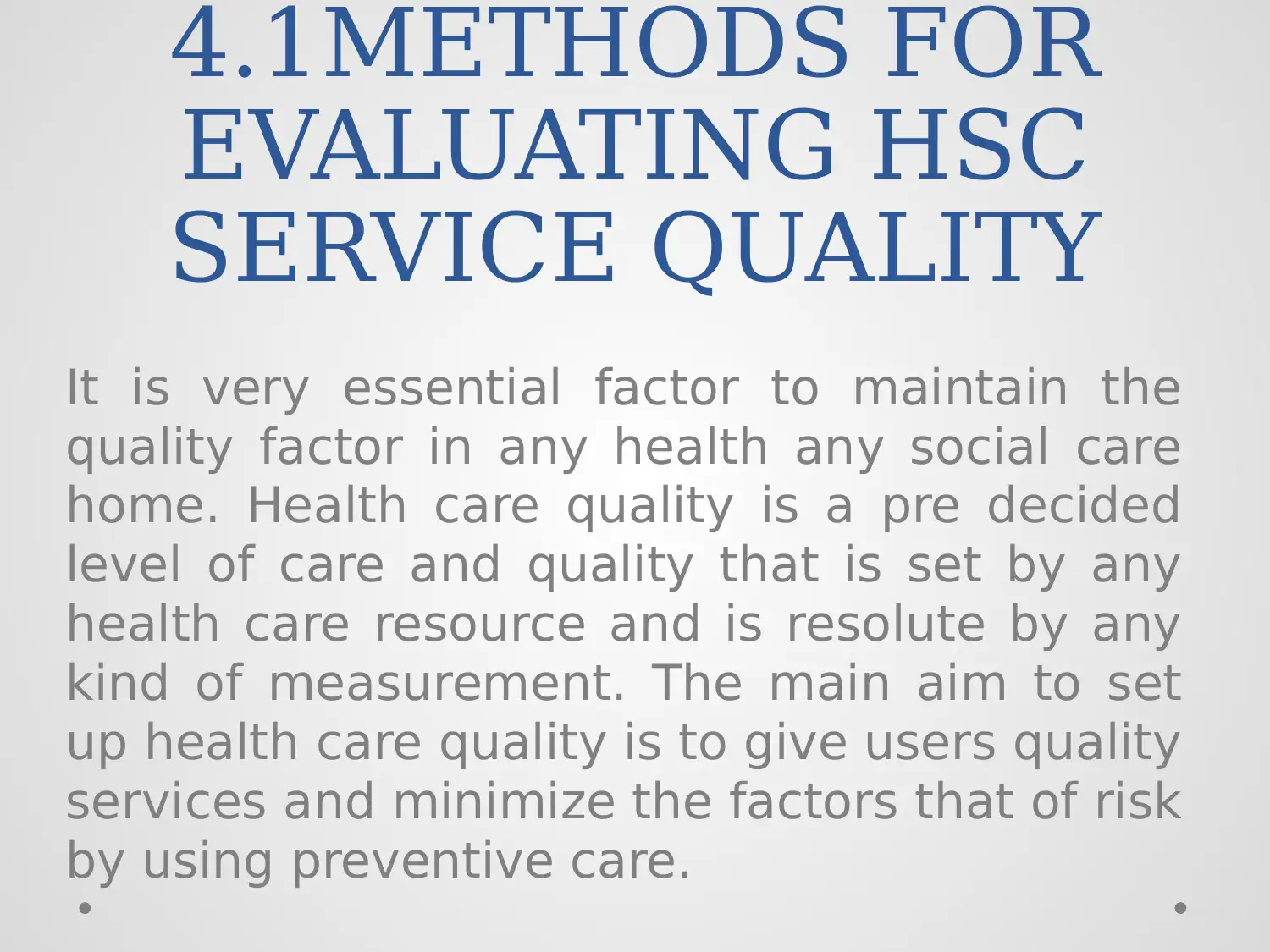
4.1METHODS FOR
EVALUATING HSC
SERVICE QUALITY
It is very essential factor to maintain the
quality factor in any health any social care
home. Health care quality is a pre decided
level of care and quality that is set by any
health care resource and is resolute by any
kind of measurement. The main aim to set
up health care quality is to give users quality
services and minimize the factors that of risk
by using preventive care.
EVALUATING HSC
SERVICE QUALITY
It is very essential factor to maintain the
quality factor in any health any social care
home. Health care quality is a pre decided
level of care and quality that is set by any
health care resource and is resolute by any
kind of measurement. The main aim to set
up health care quality is to give users quality
services and minimize the factors that of risk
by using preventive care.
Paraphrase This Document
Need a fresh take? Get an instant paraphrase of this document with our AI Paraphraser

METHODS FOR
ASSESSING SERVICE
QUALITY
There are many methods that helps to
analyses the level of service quality in HSC
centers are:
• Internal perspective that is by using
questionnaires, focus groups, panels, road
shows, structured and semi-structures
interviews etc.
• External perspective: Inspection agencies
such as CQC etc.
ASSESSING SERVICE
QUALITY
There are many methods that helps to
analyses the level of service quality in HSC
centers are:
• Internal perspective that is by using
questionnaires, focus groups, panels, road
shows, structured and semi-structures
interviews etc.
• External perspective: Inspection agencies
such as CQC etc.
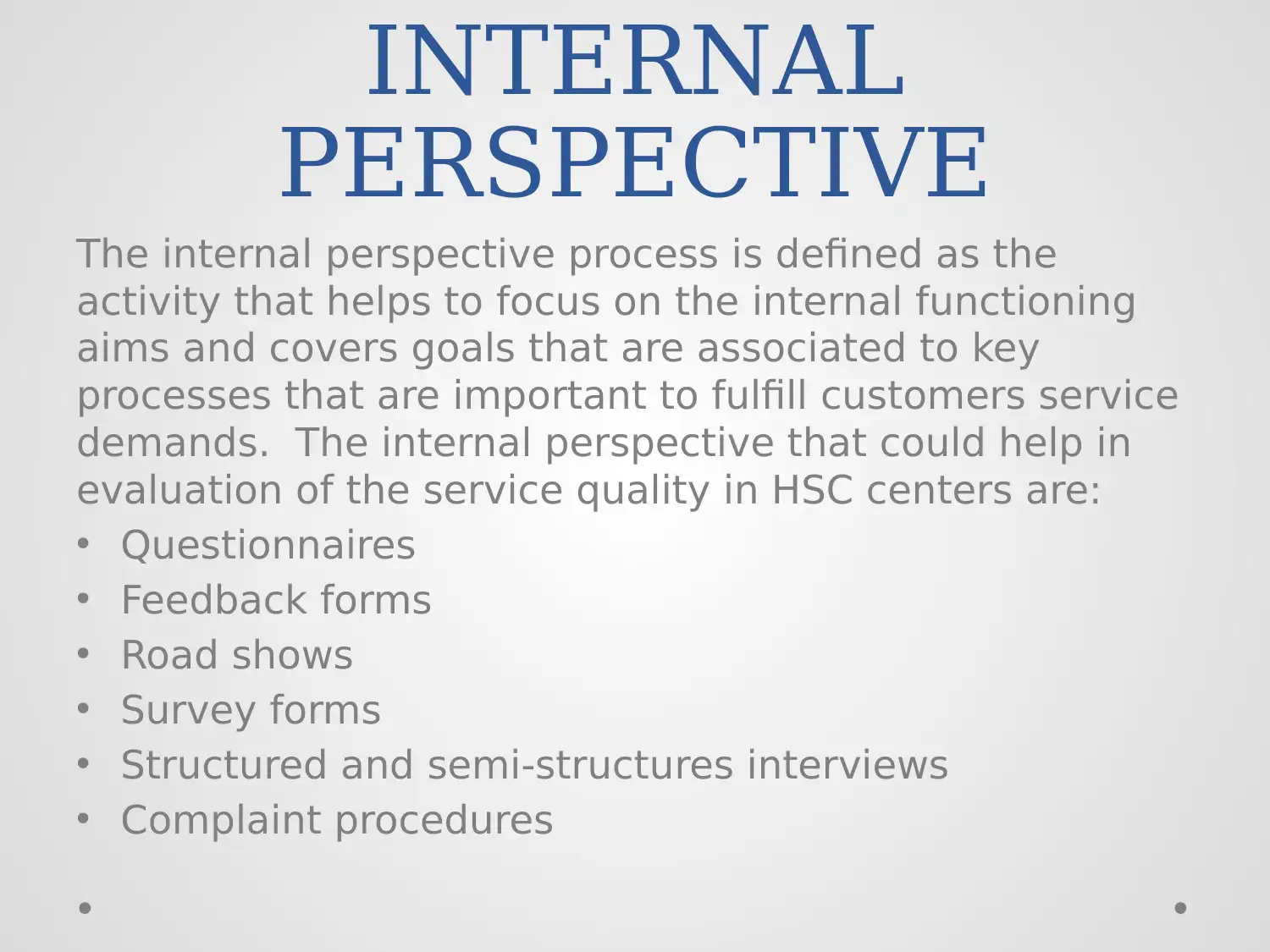
INTERNAL
PERSPECTIVE
The internal perspective process is defined as the
activity that helps to focus on the internal functioning
aims and covers goals that are associated to key
processes that are important to fulfill customers service
demands. The internal perspective that could help in
evaluation of the service quality in HSC centers are:
• Questionnaires
• Feedback forms
• Road shows
• Survey forms
• Structured and semi-structures interviews
• Complaint procedures
PERSPECTIVE
The internal perspective process is defined as the
activity that helps to focus on the internal functioning
aims and covers goals that are associated to key
processes that are important to fulfill customers service
demands. The internal perspective that could help in
evaluation of the service quality in HSC centers are:
• Questionnaires
• Feedback forms
• Road shows
• Survey forms
• Structured and semi-structures interviews
• Complaint procedures
⊘ This is a preview!⊘
Do you want full access?
Subscribe today to unlock all pages.

Trusted by 1+ million students worldwide

AND FEEDBACK
FORMS
• The questionnaire is considered as an evaluation
instrument that has several questions in an order
so that the information regarding the required
topic could be collected from the respondents.
• Feedback forms: The feedback form is a tool by
which the feedbacks of the care users is taken.
That helps in enhancing the quality of the services
based on the feedback given by the user.
FORMS
• The questionnaire is considered as an evaluation
instrument that has several questions in an order
so that the information regarding the required
topic could be collected from the respondents.
• Feedback forms: The feedback form is a tool by
which the feedbacks of the care users is taken.
That helps in enhancing the quality of the services
based on the feedback given by the user.
Paraphrase This Document
Need a fresh take? Get an instant paraphrase of this document with our AI Paraphraser

STRUCTURED
INTERVIEWS
• A semi-structured interview is a type of meeting
under which the one who take interview do not
adopt a formal set of listed questions. The
interviewers asks questions more open ended
that leads to an effective discussion instead of s
straight forward question answer pattern.
• A structured interview is a type of quantitative
research approach that is usually used to conduct
survey research.
INTERVIEWS
• A semi-structured interview is a type of meeting
under which the one who take interview do not
adopt a formal set of listed questions. The
interviewers asks questions more open ended
that leads to an effective discussion instead of s
straight forward question answer pattern.
• A structured interview is a type of quantitative
research approach that is usually used to conduct
survey research.
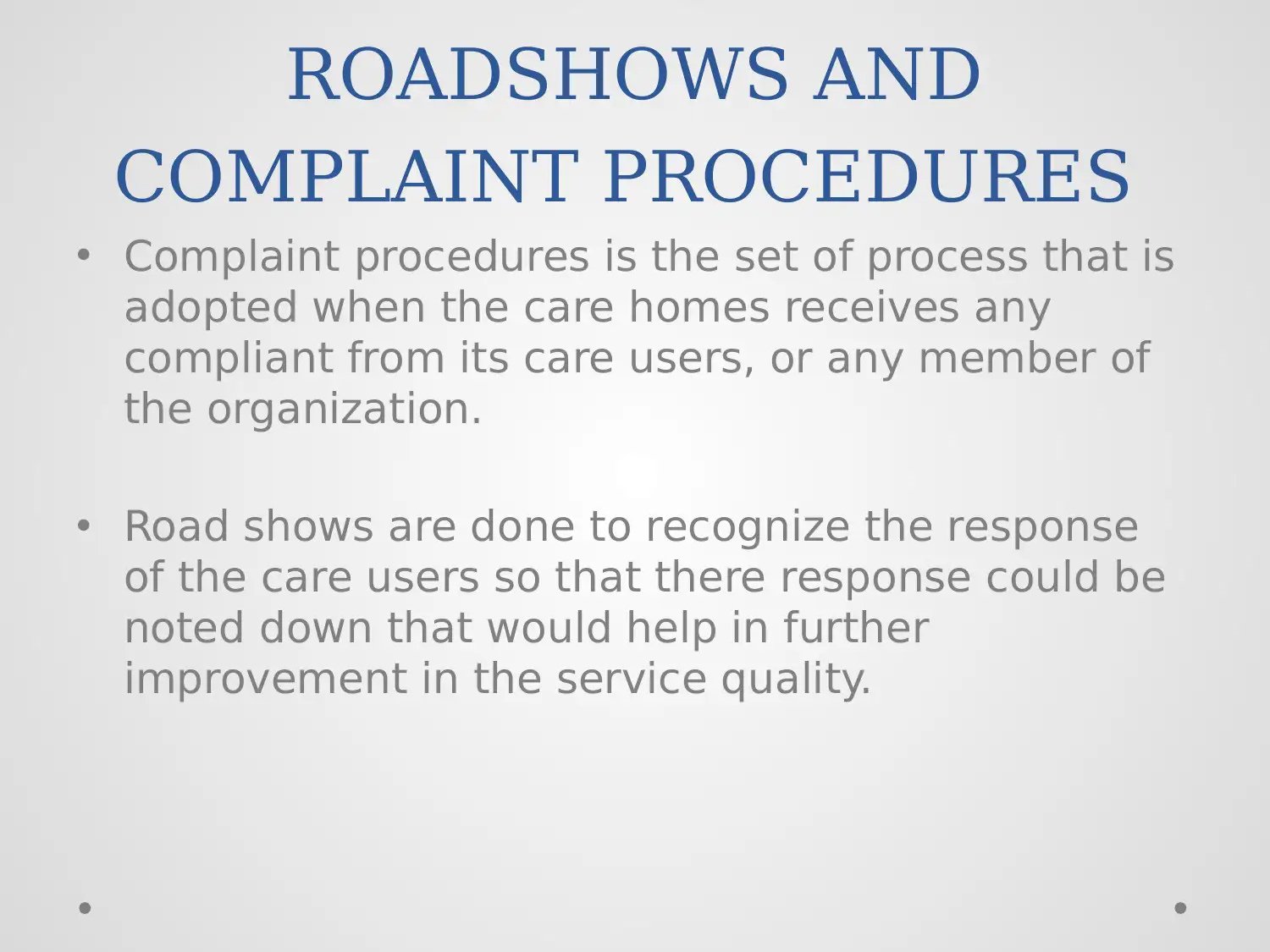
ROADSHOWS AND
COMPLAINT PROCEDURES
• Complaint procedures is the set of process that is
adopted when the care homes receives any
compliant from its care users, or any member of
the organization.
• Road shows are done to recognize the response
of the care users so that there response could be
noted down that would help in further
improvement in the service quality.
COMPLAINT PROCEDURES
• Complaint procedures is the set of process that is
adopted when the care homes receives any
compliant from its care users, or any member of
the organization.
• Road shows are done to recognize the response
of the care users so that there response could be
noted down that would help in further
improvement in the service quality.
⊘ This is a preview!⊘
Do you want full access?
Subscribe today to unlock all pages.

Trusted by 1+ million students worldwide
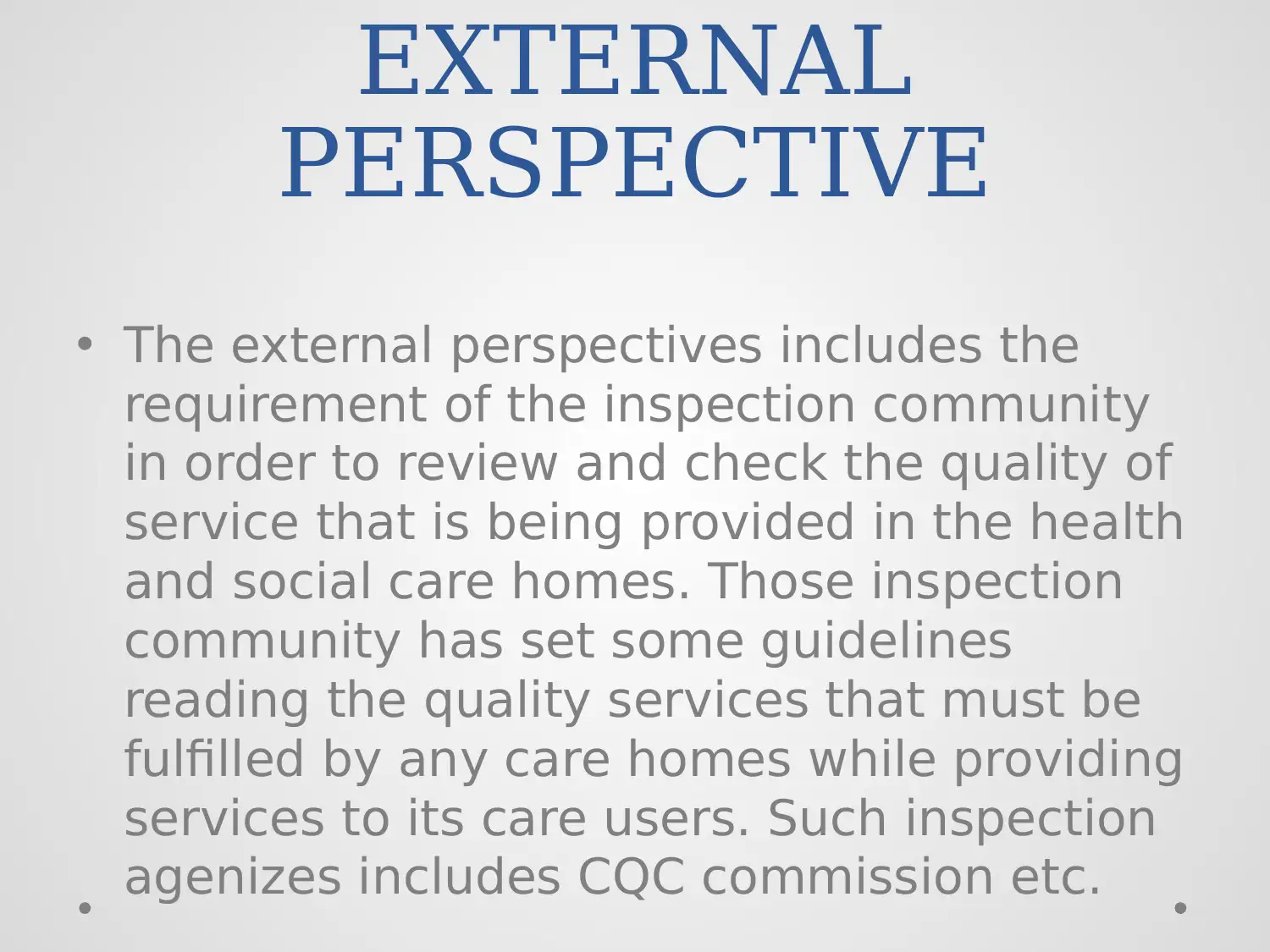
EXTERNAL
PERSPECTIVE
• The external perspectives includes the
requirement of the inspection community
in order to review and check the quality of
service that is being provided in the health
and social care homes. Those inspection
community has set some guidelines
reading the quality services that must be
fulfilled by any care homes while providing
services to its care users. Such inspection
agenizes includes CQC commission etc.
PERSPECTIVE
• The external perspectives includes the
requirement of the inspection community
in order to review and check the quality of
service that is being provided in the health
and social care homes. Those inspection
community has set some guidelines
reading the quality services that must be
fulfilled by any care homes while providing
services to its care users. Such inspection
agenizes includes CQC commission etc.
Paraphrase This Document
Need a fresh take? Get an instant paraphrase of this document with our AI Paraphraser
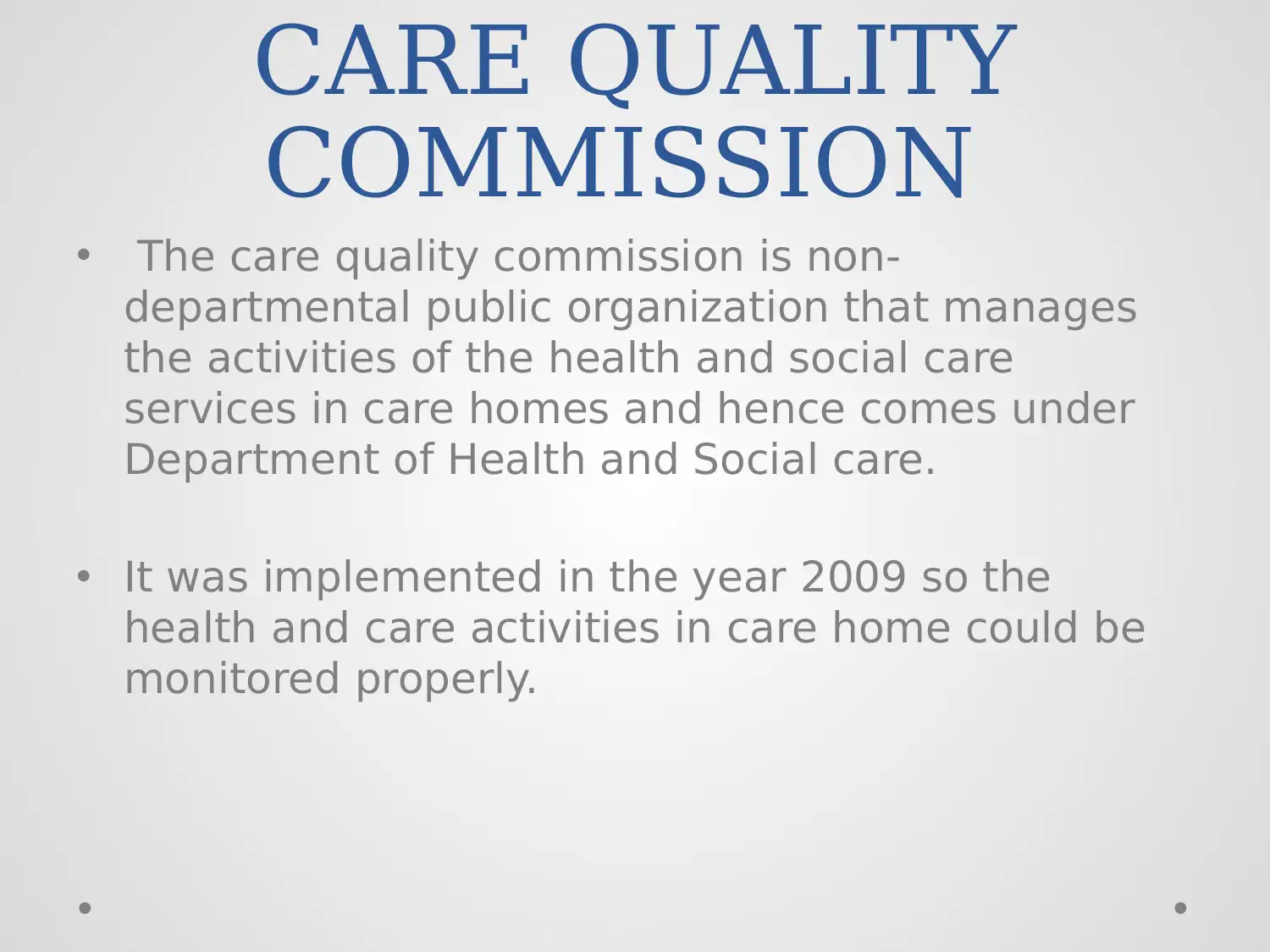
CARE QUALITY
COMMISSION
• The care quality commission is non-
departmental public organization that manages
the activities of the health and social care
services in care homes and hence comes under
Department of Health and Social care.
• It was implemented in the year 2009 so the
health and care activities in care home could be
monitored properly.
COMMISSION
• The care quality commission is non-
departmental public organization that manages
the activities of the health and social care
services in care homes and hence comes under
Department of Health and Social care.
• It was implemented in the year 2009 so the
health and care activities in care home could be
monitored properly.

4.2 IMPACTS OF INVOLVING THE
SERVICE USERS IN EVALUATION
PROCESS
• The affect of involving the service users in the
evaluation process could have both positive as
we’ll as negative impact.
• The NHS community care act, 1990 as well as
Health and social care act 2001, states that it is
mandatory for any health and social care home to
include its care users in the process of decision
making with regards to there choices and the
potential needed for delivering care.
SERVICE USERS IN EVALUATION
PROCESS
• The affect of involving the service users in the
evaluation process could have both positive as
we’ll as negative impact.
• The NHS community care act, 1990 as well as
Health and social care act 2001, states that it is
mandatory for any health and social care home to
include its care users in the process of decision
making with regards to there choices and the
potential needed for delivering care.
⊘ This is a preview!⊘
Do you want full access?
Subscribe today to unlock all pages.

Trusted by 1+ million students worldwide
1 out of 17
Related Documents
Your All-in-One AI-Powered Toolkit for Academic Success.
+13062052269
info@desklib.com
Available 24*7 on WhatsApp / Email
![[object Object]](/_next/static/media/star-bottom.7253800d.svg)
Unlock your academic potential
Copyright © 2020–2025 A2Z Services. All Rights Reserved. Developed and managed by ZUCOL.





